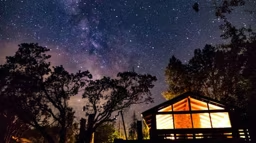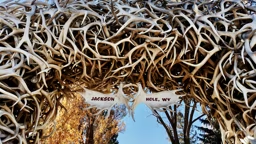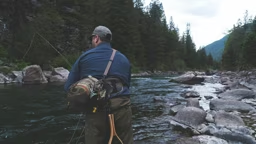The social type
Eagles of all ages are very social creatures when not defending their nests, food and airspace. Though mated eagles may not migrate with each other, eagles as a whole tend to migrate together, feed together and appear to enjoy all sorts of social interactions – interactions that are sometimes played out in spectacular air shows.
Perhaps most fascinating of all behavior is the wild social tumbling and talon locking that so many eagles participate in while migrating from place to place. One eagle approaches the other in flight, and, as the two airborne behemoths merge in the same airspace, they will roll like fighter planes, extending talons and locking their feet together.
Though many associate the tumbling of eagles with mating, it often appears as casual, flirtatious behavior, even occurring between young birds.
Prime roosts and meaty morsels are often a source of contention, and eagles wage amazing “air-to-ground” attacks on each other. The ensuing conflict ends with one bird leaping up from the roost and talon locking with the intruder. One bird lands on the prize, and the other flies off in defeat.
Eagle watching
In general, Alaska has the greatest number of eagles, but bald eagles are very abundant in the Great Lakes states, Florida and some states along the Atlantic and Pacific oceans. For the rest of the Lower 48, eagles usually are most common along major rivers or in areas with many lakes.
If you have an abundance of eagles in your neck of the woods, your area probably boasts three things: productive waters, good places to roost and large trees for nesting.
If eagles can find the means to feed a family and build a lofty home, they are sure to be around. Often, they are quite predictable in their choices of favorite roosts, and I have enjoyed watching eagles along a few local rivers simply by returning to the same cottonwood trees year after year with binoculars and camera.
Some of the most amazing bald eagle-watching occurs seasonally along the Chilkat River in Alaska, or near the open waters of an otherwise frozen Mississippi River from November to March.
But with the increasing success of the bald eagle, anyone in cabin country probably has easy access to eagle watching.
If your location fits the profile of good eagle country, a little research and detective work will help you find some excellent eagle watching. Surprisingly, many who live in eagle country still have never enjoyed an eagle encounter. If you have a favorite eagle spot, be sure to share it with someone young. While that youngster watches, perhaps grinning ear-to-ear, be sure to explain the story of the eagle – the amazing symbol of our nation. l
Brian M. Collins is an avid eagle watcher along the mighty Mississippi River, following eagles from St. Croix Falls, Wis., to New Albin, Iowa. Check out his nature photography at www.imagesinnaturallight.com.
Dad’s paddle dipped deep into clear water, pushing the canoe past a swirling current around river rocks. I was young and seated in the middle of the canoe. My brother navigated jagged rocks from his bow seat, while my father paddled and steered from the stern. With my stocking hat pulled low, I huddled against our packs and faced backward, looking at Dad. Morning sun slowly warmed the chilly air in the northern wilderness.
Suddenly, from over the treetops, an adult bald eagle, its head and tail brilliantly white, dipped a wing over the river. It climbed skyward for a moment, then swept back down to the surface of the river. Gracefully, and seemingly on the end of a single, middle talon, the eagle snagged a medium-sized fish from the water just behind our canoe. The fish, silvery in the sun, wiggled slightly as the eagle powered away over the treetops.
I had never seen a bald eagle so clearly. The year was 1982, and eagles were still recovering from a close brush with extinction. Three decades of spraying DDT (and other chemicals) on agricultural crops had nearly decimated the United States’ symbol of might.
Nowadays, I teach high school biology. My students view the eagles in our area as common birds – which they now are. Many young people don’t realize there was a time when the bald eagle was a national symbol teetering on the brink of extinction.
The life of a majestic bird
Bald eagles (Haliaeetus leucocephalis) are fascinating creatures. With impressive wingspans of up to eight feet, fierce eyes, bold feathering, needle-sharp talons and a formidably hooked beak, eagles thrill us with their power, their grace – and the freedom they symbolize.
Despite their large size, eagles’ flight depends upon hollow bones and lightweight feathers, and they are often long-distance flyers with a need to carry fairly heavy prey. For this reason, these seemingly huge birds tend to top out at around 13 pounds. Females are typically larger than males, often up to 30 percent larger, and young birds do not attain maturity until they are 4 years old.
Very young birds are usually the darkest with a chocolate brown body, black beak and dark, brown eyes. Then, young birds become speckled with whitish body feathers on their chest and under their wings. In their fourth year, they begin to develop white heads and tails.
Newly mature birds may have dark streaks on their white heads, sometimes giving them an eye stripe reminiscent of an osprey. Younger birds often appear larger than adults, as longer tail feathers offer good brakes – an insurance policy for inexperienced pilots.
Around the world, eagles come in a variety of types, shapes and sizes. Bald eagles are classified as fishing eagles, though they will gladly feast on carrion. While bald eagles have traditionally relied on snagging fish from the surface of the water, modern-day eagles also can enjoy a smorgasbord of fresh roadkill along the nation’s roadways. Thus eagles today are found in some locations even after the last bodies of water have frozen solid in winter.
Suddenly, from over the treetops, an adult bald eagle, its head and tail brilliantly white, dipped a wing over the river. It climbed skyward for a moment, then swept back down to the surface of the river. Gracefully, and seemingly on the end of a single, middle talon, the eagle snagged a medium-sized fish from the water just behind our canoe. The fish, silvery in the sun, wiggled slightly as the eagle powered away over the treetops.
I had never seen a bald eagle so clearly. The year was 1982, and eagles were still recovering from a close brush with extinction. Three decades of spraying DDT (and other chemicals) on agricultural crops had nearly decimated the United States’ symbol of might.
Nowadays, I teach high school biology. My students view the eagles in our area as common birds – which they now are. Many young people don’t realize there was a time when the bald eagle was a national symbol teetering on the brink of extinction.
The life of a majestic bird
Bald eagles (Haliaeetus leucocephalis) are fascinating creatures. With impressive wingspans of up to eight feet, fierce eyes, bold feathering, needle-sharp talons and a formidably hooked beak, eagles thrill us with their power, their grace – and the freedom they symbolize.
Despite their large size, eagles’ flight depends upon hollow bones and lightweight feathers, and they are often long-distance flyers with a need to carry fairly heavy prey. For this reason, these seemingly huge birds tend to top out at around 13 pounds. Females are typically larger than males, often up to 30 percent larger, and young birds do not attain maturity until they are 4 years old.
Very young birds are usually the darkest with a chocolate brown body, black beak and dark, brown eyes. Then, young birds become speckled with whitish body feathers on their chest and under their wings. In their fourth year, they begin to develop white heads and tails.
Newly mature birds may have dark streaks on their white heads, sometimes giving them an eye stripe reminiscent of an osprey. Younger birds often appear larger than adults, as longer tail feathers offer good brakes – an insurance policy for inexperienced pilots.
Around the world, eagles come in a variety of types, shapes and sizes. Bald eagles are classified as fishing eagles, though they will gladly feast on carrion. While bald eagles have traditionally relied on snagging fish from the surface of the water, modern-day eagles also can enjoy a smorgasbord of fresh roadkill along the nation’s roadways. Thus eagles today are found in some locations even after the last bodies of water have frozen solid in winter.
 Brian M. Collins
Brian M. Collins  Gregorius Gp Buir, dreamstime.com
Gregorius Gp Buir, dreamstime.com 









